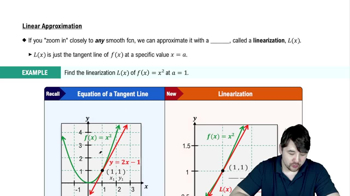Table of contents
- 0. Functions7h 52m
- Introduction to Functions16m
- Piecewise Functions10m
- Properties of Functions9m
- Common Functions1h 8m
- Transformations5m
- Combining Functions27m
- Exponent rules32m
- Exponential Functions28m
- Logarithmic Functions24m
- Properties of Logarithms34m
- Exponential & Logarithmic Equations35m
- Introduction to Trigonometric Functions38m
- Graphs of Trigonometric Functions44m
- Trigonometric Identities47m
- Inverse Trigonometric Functions48m
- 1. Limits and Continuity2h 2m
- 2. Intro to Derivatives1h 33m
- 3. Techniques of Differentiation3h 18m
- 4. Applications of Derivatives2h 38m
- 5. Graphical Applications of Derivatives6h 2m
- 6. Derivatives of Inverse, Exponential, & Logarithmic Functions2h 37m
- 7. Antiderivatives & Indefinite Integrals1h 26m
- 8. Definite Integrals3h 25m
4. Applications of Derivatives
Linearization
Problem 20
Textbook Question
Drag racer acceleration The fastest drag racers can reach a speed of 330 mi/hr over a quarter-mile strip in 4.45 seconds (from a standing start). Complete the following sentence about such a drag racer: At some point during the race, the maximum acceleration of the drag racer is at least _____ mi/hr/s. .
 Verified step by step guidance
Verified step by step guidance1
Convert the speed from miles per hour to miles per second to make calculations easier. Since there are 3600 seconds in an hour, divide 330 mi/hr by 3600 to get the speed in mi/s.
Determine the distance of the quarter-mile strip in miles. A quarter-mile is equal to 0.25 miles.
Use the formula for acceleration, which is defined as the change in velocity divided by the time taken. The formula is a = (final velocity - initial velocity) / time. Here, the initial velocity is 0 mi/s, and the final velocity is the speed you calculated in mi/s.
Substitute the values into the acceleration formula to find the average acceleration over the entire distance and time. This will give you the average acceleration during the race.
To find the maximum acceleration, consider that the drag racer may accelerate faster than the average at some point during the race. Use the average acceleration as a lower bound for the maximum acceleration.
Recommended similar problem, with video answer:
 Verified Solution
Verified SolutionThis video solution was recommended by our tutors as helpful for the problem above
Video duration:
2mPlay a video:
Was this helpful?
Related Videos
Related Practice




